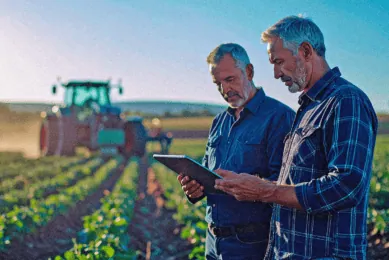Harvesting sugar cane more efficiently with AI and IoT

Harvesting and transportation accounts for one third of the total production costs of sugar from sugar cane. To be more efficient, Bevap brought artificial intelligence and the Internet of Things into this process. This resulted in 8% increased efficiency representing € 150 million.
Sugar cane production in Brazil amounts to 769 million tonnes per year. A typical factory processes 2 million tonnes. Companies are challenged every day to reduce costs, with harvest and transport being responsible for more than 30% of the total.
Bevap understood that it could reduce costs by optimising the harvest. It identified points that could be automated to reach the expected return. To be even more efficient, Bevap brought artificial intelligence (AI) and the Internet of Things (IoT) into the process.
Text continues underneath image
Mobility to the field
Bevap, in João Pinheiro, has more than 1,500 employees and processes 15 thousand tonnes of sugar cane per day into sugar and ethanol. The required energy is generated by burning bagasse, the remains of the sugar cane after processing. Bevap took the initial step into the connected and mobile world in 2017 by replacing the hand written delivery notes with tablets. This brought significant operating gains, but also qualified the activities of employees engaged in farming, trucks and agricultural equipment through mobility.
“We have achieved much more than expressive operational gains. The project to bring mobility to the field has generated another value to the business by digitally including professionals who could not imagine using a tablet in their day to day work,” says Fabio André Ramos, information technology manager.
Bevaps harvesting process was largely composed of manual actions. The aim was to find a solution for:
- harvest and transshipment;
- transport and internal logistics;
- digital certification of cane;
- telemetry.
Previously, all was carried out manually with the help of radios and supervisors registering the harvest on delivery notes. Even with doing this well, it was not possible to achieve the required efficiency and cost reduction. It was also impossible to make optimum use of the fleet. The harvester often had to idly wait for a transport tractor.
Text continues underneath image
Real-time information
The transport tractors were equipped with on-board computers from Solinftec. Using Internet of Things technology (IoT), they communicate with harvesters. These communicate mutually, and by using machine learning they make calculations of travel time, tipping time, routes, and identify which equipment the harvester should call when it finishes loading the transport.
In this way, information is exchanged and data locally processed. The data are then transmitted to the transport truck, which forwards data obtained in the field to the weighing scale at the yard of the sugar mill by means of sensors in the scales. In parallel, the information is transmitted via the internet to a cloud server. The data is then available to the monitoring centre for all necessary analysis.
Text continues underneath image
In the new scenario everything can be monitored the moment things happen on the 30 thousand hectares, thus facilitating and streamlining decision making. The on-board computers display the status of the trucks (loaded, empty, waiting for loading, or in the yard of the mill). Artificial intelligence turbines the system, which has its transportation optimised by performing automatic dispatches of trucks to point of harvest, in the same way that eliminates problems of lack or excess of trucks at the point of harvest.
Digital certificate
Before, a supervisor registered the harvest per truck manually. Any mistake could cause huge losses to the plant. So Bevap implemented the digital cane certificate, retiring the paper delivery note. All information is generated automatically by on-board computers. The location data of farm, pivot and field, equipment and operators involved in harvesting, as well as the respective operations (notes) are automatically transmitted to the balance as soon as the transport truck enters for weighing.
Also a vehicle telemetry system was implemented. This allows the automotive maintenance sector on-line monitoring of the fleets and provides telemetry data (idle motor, oil pressure, engine temperature, state of transport-belts, etc.). These data are captured from the equipment and transmitted to the automotive workshop monitoring screen.
Text continues underneath image
Gains in efficiency
By bringing AI and IoT to the process of harvesting, transshipping and transport, Bevap gained efficiency and productivity. It required organisational change from the ground up, leveraging a combination of technology, people, and processes. Expertise in gathering, cleaning, integrating and analysing huge amounts of data was developed. Important was understanding that this was not just about IoT data alone, but about the power of combining sensor data with other sources like enterprise data, third-party data and open public data (e.g. weather). The efficiency of the operation increased by 8%, or € 150 million.
Sugar production under pressure
The Gross Domestic Product (GDP) in Brazil was worth US $ 2,056 billion in 2017. Agriculture and agribusiness contributed 23.5%, according to an estimate by CNA, a farm lobby. In 2018 the GDP grew 1,1%. However, the contribution of the agribusiness grew only 0,1% and sugar cane had a negative growth of 2%. In the case of sugar cane, the estimated reduction in sales is a reflection of the fall in prices (-10.6%) and production (-2.8%) in 2018. According to the Ministry of Agriculture, this harvest presented the second consecutive decrease of area, which can be attributed to the return of leased land and preference for cultivation of crops with greater profitability. In addition, sugar cane plantations have been showing a reduction in productivity due to the evolution of mechanised harvesting. The decline in prices is especially related to the devaluation of sugar.
Join 17,000+ subscribers
Subscribe to our newsletter to stay updated about all the need-to-know content in the agricultural sector, two times a week.



